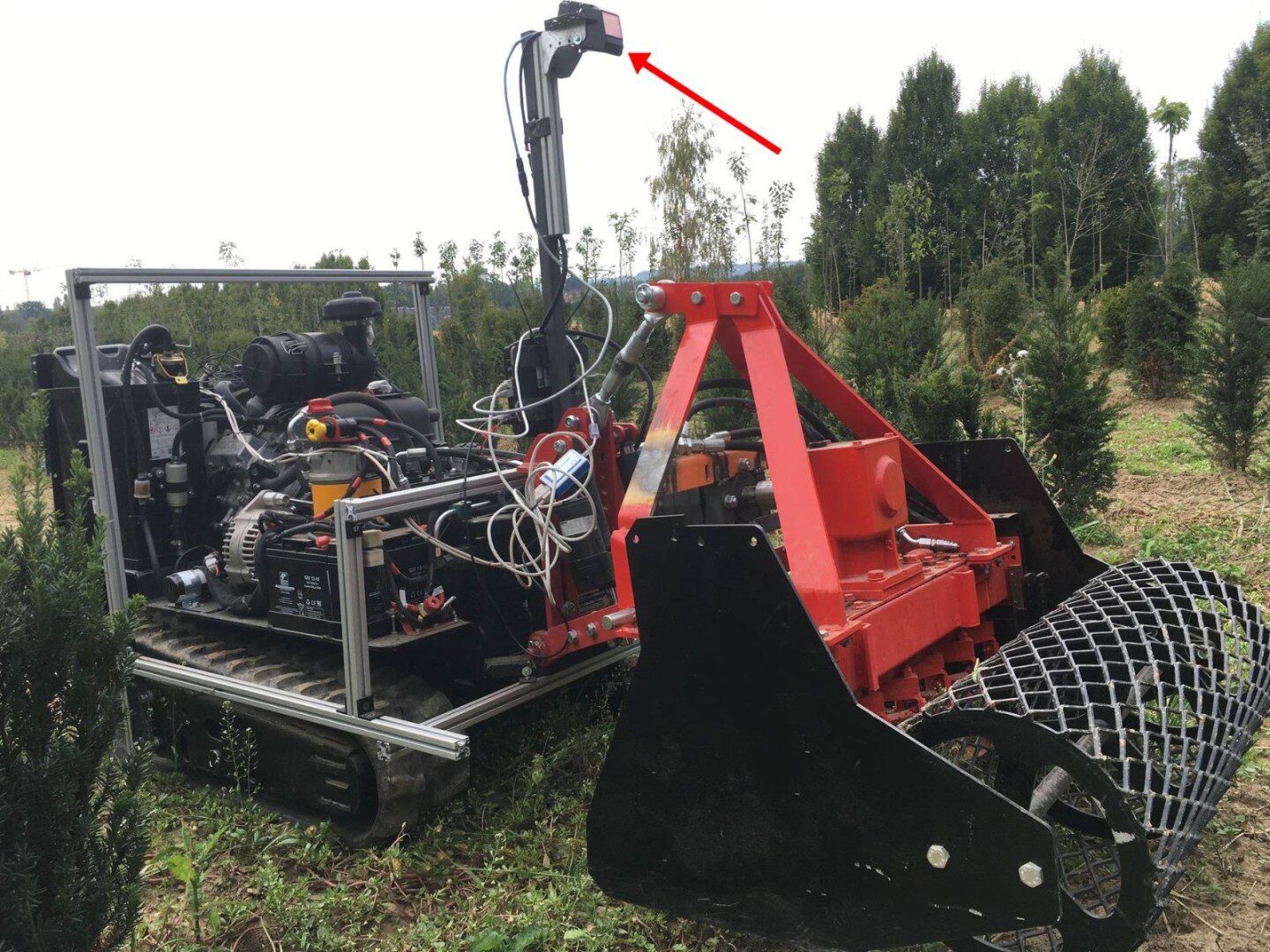
The LiDAR scanner (red arrow) installed in AMU-Bot continuously emits laser pulses as the vehicle moves, which the system uses to determine the position of the crop rows.
via Federal Office of Agriculture and Food/Fraunhofer
Fraunhofer researchers have collaborated with partners to develop a platform to remove weeds fully automatically.
The mobile AMU-Bot robot system navigates using optical sensors and removes weeds mechanically without the need for chemicals. The researchers have also been working on a comprehensive, data-supported ecosystem for the resource-efficient and environmentally friendly automation of agricultural processes.
Weeds in tree nurseries, vegetable gardens and orchards are a grower’s worst nightmare. Especially in the early stages of the crop’s growth, weeds compete with crops for water, light and nutrients. Removing them by manual hoeing is labor-intensive and using herbicides is far from ideal as they pollute the environment. The Fraunhofer Institute for Manufacturing Engineering and Automation IPA in Stuttgart has joined forces with partners to develop a mobile, mechanical system that reliably removes weeds in a cost-effective and environmentally friendly manner. The autonomous caterpillar vehicle, AMU-Bot (“AMU” being short for “autonomous mechanical weed control” in German), drives between the rows of saplings in the tree nursery and removes any weeds using rotary harrows. The rotating blades are attached to a height-adjustable manipulator. At the end of the row of trees, the caterpillar vehicle turns around and autonomously starts on the next row.
Navigation with LiDAR scanners
The project team, headed by Kevin Bregler (Head of Field Robotics at the Robot and Assistive Systems department), together with partners Bosch and KommTek used optical sensors for the navigation system. The LiDAR (light detection and ranging) scanners installed in the robot system continuously emit laser pulses as the vehicle moves, which are then reflected by objects in the surrounding area. The distances to these objects can be calculated based on the time it takes for the reflected laser pulses to reach the sensor again. This produces a 3D point cloud of the environment. The robot system uses this to find its way and determine the position of plants or trees.
Kevin Bregler explains: “AMU-Bot is not yet able to classify all plants; however, it can recognize crops such as trees and shrubs in the rows of the tree nursery cultivations. Moreover, the distances between the individual crops are calculated. Using this information, the weeds can then be reliably removed. The robot uses these data to navigate along the rows while the manipulator removes any weeds.”
Even weeds in the spaces between the plants or trees can be reliably killed off. To that end, the manipulator moves into the gaps between the crops. The weeds do not need to be collected and are left on the ground to dry out. Thanks to its caterpillar drive, the self-driving weed killer moves along the ground with ease and is extremely stable. Even holes in the ground created when saplings are removed do not pose a problem for AMU-Bot. The AMU-Bot platform is economical, robust, easy to operate and highly efficient. Rotary harrows, for example, have long since proven successful in agriculture. They are often used to break up the soil prior to sowing crops. Fraunhofer expert Bregler says: “Removing weeds is a very relevant topic and one that is rather complex. There are various approaches that can be taken: grubbing, cutting, hoeing, flaming or treating the weeds with herbicides. However, herbicides are no longer popular, especially in ecological agriculture and for tree nurseries or orchards. Our method completely avoids the use of chemicals.”
Robust, reliable and cost-effective
The project managers made a conscious decision to develop a seemingly simple solution. “A system that classifies the different individual plants requires high-resolution cameras, AI-supported image recognition algorithms and plant profiles stored in a database. These systems are far more complex and expensive. Not only that, but they cannot readily switch to working in new contexts,” explains Bregler. In comparison, the AMU-Bot platform relies on the sophisticated interplay of three fully developed modules: caterpillar vehicle, navigator system and manipulator. AMU-Bot is also the result of an efficient partnership. Bosch is responsible for the navigation and sensor system, while KommTek developed the caterpillar drive. Fraunhofer IPA engineered the height-adjustable manipulator, including rotary harrows, and was responsible for overall coordination.
The project was supported by the German Federal Ministry of Food and Agriculture (BMEL) and the German Federal Office of Agriculture and Food (BLE) was the project sponsor. The Fraunhofer experts are already planning the next step. Together with seven other Fraunhofer Institutes, IPA expert Kevin Bregler and the project team are working on a new, high-performance ecosystem called COGNAC (Cognitive Agriculture). Digital services and data, which also include interactions between biospheres and production, are networked to form this ecosystem. In addition, COGNAC integrates intelligent sensors and robotics. The aim is to create flexible and intelligent automation of sustainable agriculture—including weed control.
Original Article: Mobile weed killer for tree nurseries
More from: Fraunhofer Society
The Latest Updates from Bing News & Google News
Go deeper with Bing News on:
Autonomous mechanical weed control
- Boosting crop colors with gene editing can improve weed control
At the heart of this progressive strategy lies the concept of modifying the composition of crops with gene editing ...
- Are alternative weed control techniques viable for beet?
With sugar beet herbicide options dwindling, researchers are testing options using artificial intelligence and robotics. Mike Abram reports German field ...
- Farming News - AMAZONE to showcase a range of new kit at CEREALS 2024
AMAZONE Ltd will again take the opportunity at Cereals 2024 to showcase kit that reflects the shifting trends in crop establishment. These shifting trends are also supported by government help through ...
- Habitat at Home: How to make your yard firefly friendly
Avoid using broad-spectrum insecticides like malathion and diazinon.Pull weeds by handUse mulch and cardboard to kill weeds in large areasUse a homemade weed killer: Mix one cup of salt, 1 tablespoon ...
Go deeper with Google Headlines on:
Autonomous mechanical weed control
[google_news title=”” keyword=”autonomous mechanical weed control” num_posts=”5″ blurb_length=”0″ show_thumb=”left”]
Go deeper with Bing News on:
Automation of agricultural processes
- Field of vision: How woman-run Stereolabs brings AI to agriculture
Stereolabs has spent the past few years integrating its ZED camera into agricultural equipment to build autonomous, data-driven machines.
- 7 Reasons Artificial Intelligence Raises Concerns for Agriculture Farmers
The integration of artificial intelligence into agriculture brings both promise and concern for farmers worldwide. As AI-driven solutions reshape farming practices, farmers grapple with challenges ...
- How will AI impact farming?
Artificial intelligence could further speed farm growth and consolidation, some observers say. Modern tractors may look like those from two decades ago, but inside, new models have gone through a ...
- Lab Automation Market Projected to Reach USD 9.14 billion by 2031, Expanding at a CAGR of 6.19%
According to SNS Insider the Lab Automation market is projected to reach USD 9.14 billion by 2031 from USD 5.74 billion in 2023 and grow at a CAGR of 6.19% over the forecast perio ...
- The Impact of Artificial Intelligence on Job Market Trends
Are robots taking over our jobs? Will artificial intelligence make human labor obsolete? These questions have been wandering over the job market for years, sparking debates and fears about the future ...
Go deeper with Google Headlines on:
Automation of agricultural processes
[google_news title=”” keyword=”automation of agricultural processes” num_posts=”5″ blurb_length=”0″ show_thumb=”left”]









